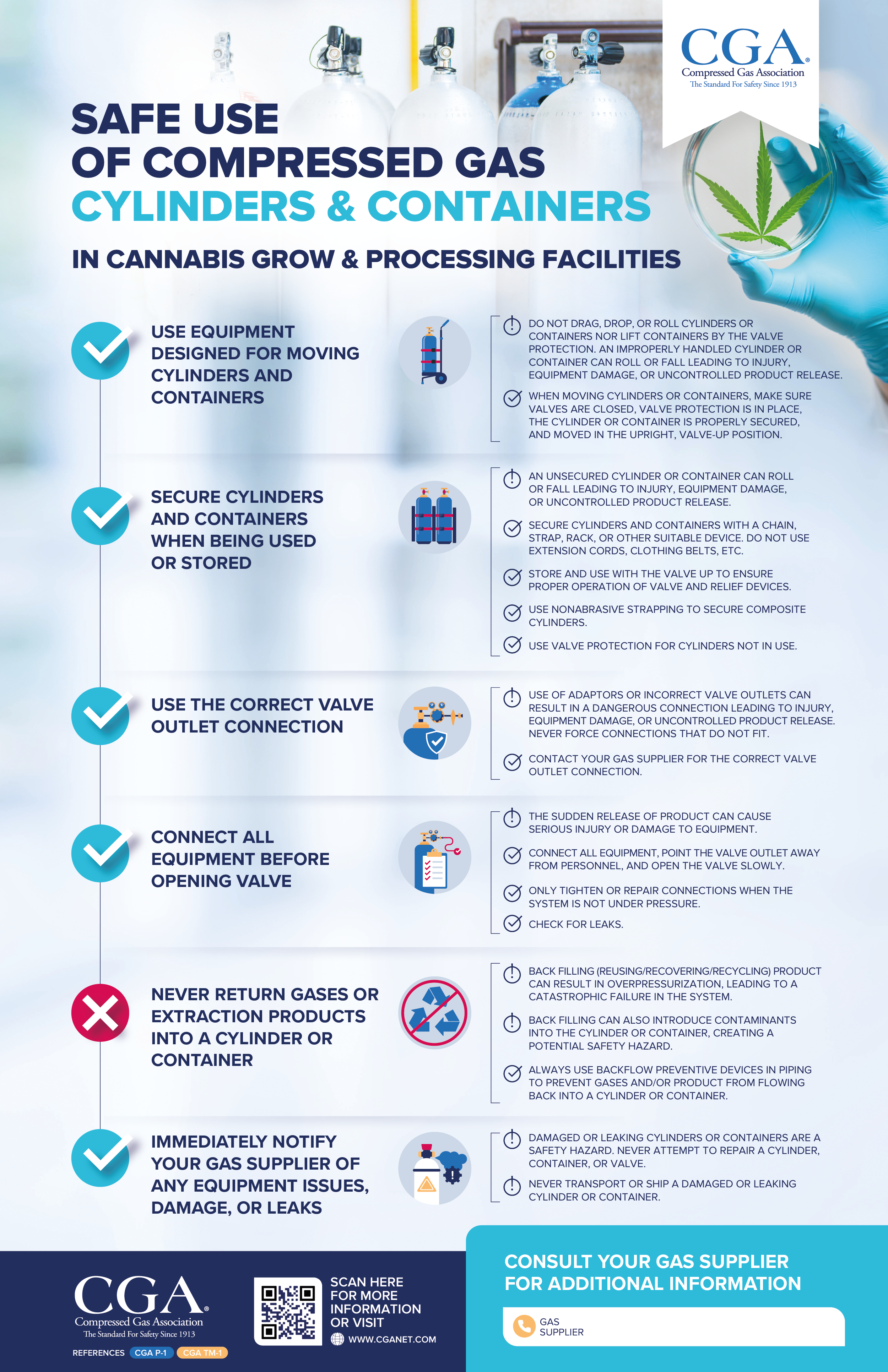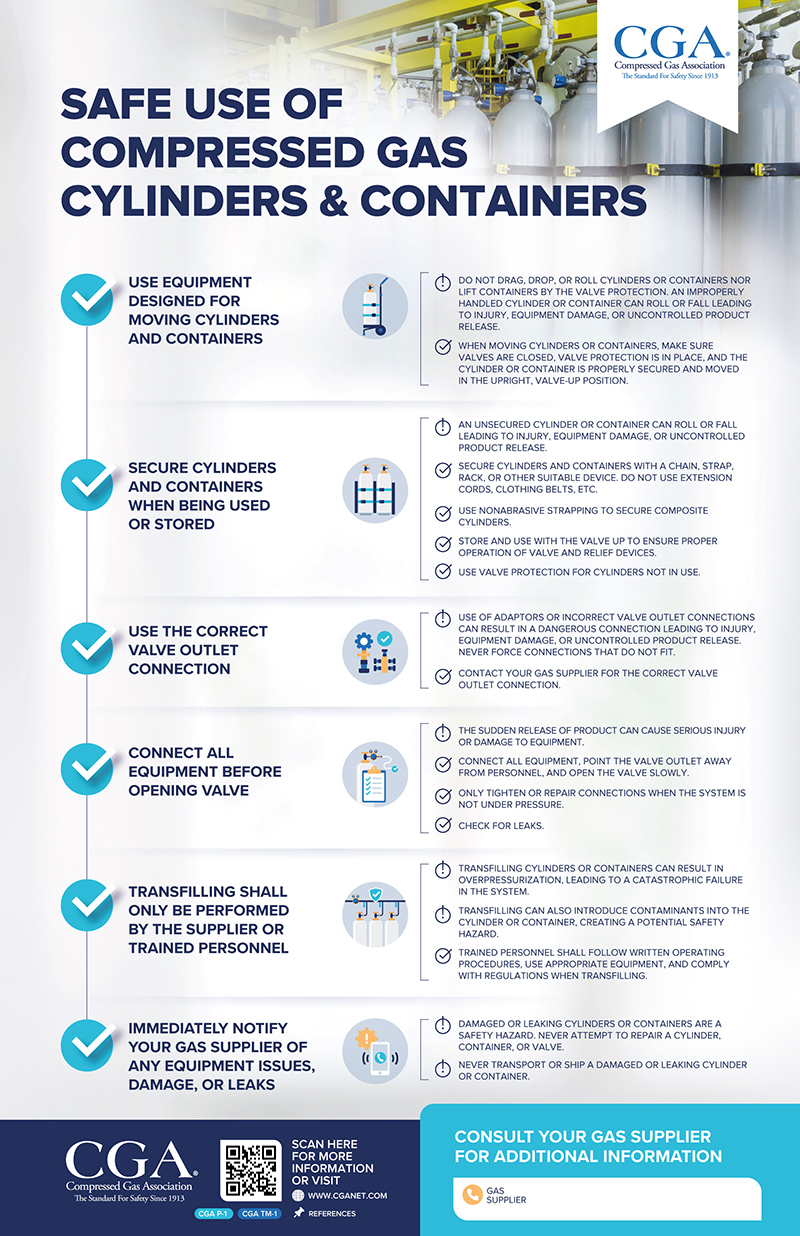Your Cylinder and Equipment Safety Resource Center
Safe Use of Compressed Gas Cylinders & Containers

Poster 1

Poster 2
Compressed and liquefied gases play a vital and growing role throughout the world and are used in a wide range of applications. These gases are stored in several different types of containers including high or low pressure cylinders, bulk containers, and pressurized and unpressurized liquid containers. Some containers are large and heavy, and some are designed to be small and lightweight for easy portability. Each type of container can be a different size, painted a different color, and can have different equipment attached. Each type of container is manufactured, marked, and labeled according to governmental specifications.
There are 5 basic responsibilities for any compressed gas cylinder or container user:
- make no modifications to the container and related equipment and maintain in good working condition;
- read and understand the cylinder or container markings and labels and make sure that they remain in legible condition with no alterations;
- store, handle, and use the cylinder or container so that it will not be damaged;
- understand the risks to safe use of the cylinder or container, assess the environment where the cylinder or container will be stored or used to ensure that conditions in the environment are compatible with the gas and container; and
- report any damage or problems to the gas supplier or distributor immediately so that the situation can be addressed.
Anyone who handles compressed gas cylinders or containers should be aware of their potential hazards and safe handling practices. This safety poster, provided by the Compressed Gas Association, provides basic safety information for the safe use of cylinders, containers, and related equipment.
Cylinder & Container Safety Reminders
- Use equipment designed for moving cylinders and containers.
- Secure cylinders and containers when being used or stored.
- Use the correct valve outlet connection.
- Connect all equipment before opening valve.
- Never return gases or other products into a cylinder or container.
- Immediately notify your gas supplier of any equipment issues, damage, or leaks.
Poster Downloads
CGA offers safety posters as educational resources to support the safe use of our industry’s products and equipment. It is important to note that these posters are not a substitute for reading and following codes and regulations, industry standards, and supplier instructions. Download your free poster today!
NOTE – Use self-print files for printing at your home or office, and full bleed files for professional printing.
Additional Resources
CGA Publications
CGA eLearning Modules
- CGA TM-1, eLearning: Safe Handling and Storage of Compressed Gases
- CGA TM-3, eLearning: Safe Handling of Cryogenic Liquids in Portable Containers
- CGA TM-7, eLearning: Introduction to Compressed Gas Cylinder Valves
CGA Free Safety Materials
- CGA SP-1, Safety Poster (Industrial), Valve Protection Caps
- CGA SP-4, Safety Poster (Industrial), The Sleeping Giant
- CGA SP-7, Safety Poster (Industrial), Proper Cart Usage for Liquid Cylinders
- CGA SP-10, Safety Poster (Industrial), Misuse of Adaptors Can be Dangerous
- CGA SP-11, Safety Poster (Industrial), Plan Your Trip to Avoid a Tip
Product Information: Cylinders, Containers, and Related Equipment
Cylinders and containers are provided by the gas supplier or distributor as a convenient device for storing and delivering a product to the user. The user is responsible for the safe handling, use, and storage of the cylinder or container and its contents and for returning it to the gas supplier or distributor in the same safe condition that it was received.
In addition to the safe handling considerations and hazards presented by cylinders, containers, and equipment, the gases contained by these vessels also present additional hazards. The hazard common to all compressed gases is pressure. It is present at all times, ready to forcefully escape at any given opportunity. When not properly controlled, it can lead to serious injury or cause equipment damage. Examples of additional hazardous properties that gases can present include:
- extremely cold;
- flammable;
- asphyxiant;
- oxidizer;
- corrosive; and
- toxic.
Some gases can have more than one of these properties. To know what specific hazards are presented by the product that you are working with, you must read and understand the safety data sheet (SDS) and product label.
The safe handling and use of compressed gases and their cylinders and containers is a responsibility of the user. There are many aspects of safety that must be followed when working with cylinders and containers, including:
- ensuring that cylinders and containers are secured during storage, transport, and use;
- maintaining storage practices that comply with code requirements and industry standards;
- using proper equipment to move cylinders and containers;
- reading the product label to verify the cylinder or container contents and understand the critical hazards and instructions for that product;
- wearing appropriate personal protective equipment (PPE) based on the product that you are working with to prevent injury;
- inspecting the cylinder or container and related equipment before use to ensure that it is clean and in good condition;
- using the correct connections, fittings, regulators, and other equipment designed for the cylinder or container, product, and equipment that you are working with;
- making sure that all gas connections are gas tight, and never attempting to tighten connections or leaking fittings, or attempt other repairs while the system is under pressure;
- maintaining residual cylinder or container pressure;
- ensuring that valve protection caps, dust caps, or plugs provided with your cylinder or container are in place when the cylinder or container is not in use or connected for use; and
- notifying your gas or equipment supplier immediately in the case of damage to or concerns with your cylinders, containers, or equipment.
It is important that all users understand these hazards and how to best mitigate them. For more information, please see CGA P-1, Standard for Safe Handling of Compressed Gases in Containers, and CGA TM-1, eLearning: Safe Handling and Storage of Compressed Gases.
Cylinders and containers can have many types of equipment attached. Some examples are defined here.
Pressure Regulator. A pressure regulator is a mechanical device used to control the discharge pressure of a compressed gas from a cylinder or container.
Pressure Relief Device. A pressure relief device (PRD), also known as a safety relief device, is a pressure or temperature activated device used to prevent the cylinder or container pressure from rising above a predetermined maximum by releasing some or all of the cylinder/container contents depending on the type of PRD.
Manifold. A manifold is a gas distribution system that transfers product through multiple outlets and inlets to compressed gas cylinders and containers and from compressed gas cylinders and containers to gas-handling equipment for end use applications.
Valve Outlet Dust Caps or Plugs. Valve outlet dust caps or plugs are removable attachments that provide covering against contamination from external sources. There are also gas-tight caps and plugs, which serve as a pressure barrier against leakage out of the valve outlet in addition to protecting the outlet from external contamination.
Valve Protection Cap or Device. A valve protection cap is a rigid removable cover provided to protect the valve during cylinder handling, transportation, and storage. A valve protection device is attached to the neck ring or body of a cylinder or container to protect the valve from being struck or damaged by impact.
An emergency response plan shall be in place wherever compressed gas cylinders, containers, and products are used, handled, stored, or disposed of according to 29 CFR 1910.120. In the event of an emergency, contact emergency response personnel (e.g., the fire department) and then contact the gas supplier or distributors.
Only trained personnel shall respond to an emergency situation involving a compressed gas cylinder, container, or product. Personnel shall be promptly evacuated from the immediate area in danger and kept upwind at a sufficient distance to avoid any inhalation or contact with potentially hazardous products until safe re-entry can be ensured. Consult the appropriate safety data sheet (SDS) or other recognized emergency response guides for specific hazards, precautionary safety measures, and related emergency response information. Select appropriate personal protective equipment.
The following are a few guidelines to help you prepare for an emergency:
- read and understand your company’s emergency response plan;
- make sure that emergency phone numbers are readily available;
- know who at your facility is qualified to lead a response in an emergency situation;
- know where your emergency response materials are located; and
- practice your response.